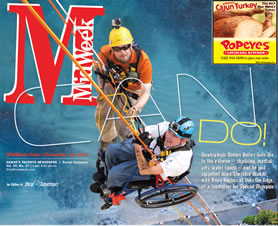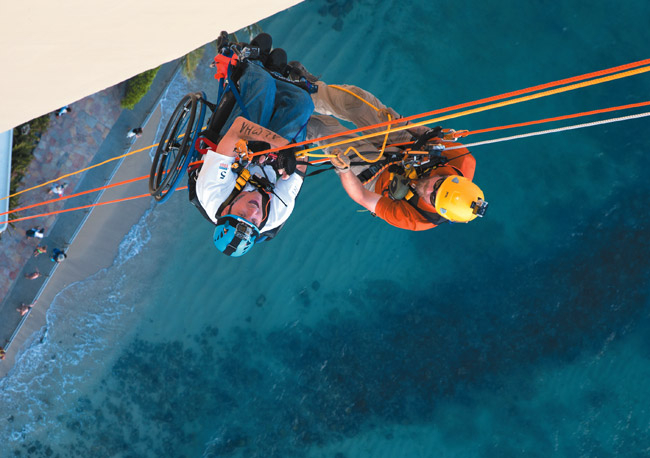Can Do!
Quadriplegic Damon Boiser is the epitome of the ‘can do’ spirit — without the use of his arms and legs, he still finds the courage and determination to go to the extreme
To paraphrase the great Green Bay Packers coach Vince Lombardi, heroes aren’t born, they’re made.
mw-cover-111313-specialolympics-1
And unlike the men the coach was trying to inspire, they do not always strut into the hot spotlight of the frozen tundra. Some are formed in the dark of night, flat on their back in a stranger’s home, willing themselves to greatness.
Today’s story is about one of the latter heroes, a man whose biggest ambition early on in life was to play guitar for Limp Bizkit just so he could proposition Madonna, and who now finds himself positioned as a man about whom high school kids will write their papers.
This man is Damon Boiser. His life began on the north shore of Kauai, where his family has lived for 10 generations. He was fortunate enough to attend Kamehameha Schools, just as his parents and grandparents had, and he sought to make his fortune in the music business. The closest he came was a tryout with the aforementioned rap metal band three years after it had peaked, and upon missing the cut, took refuge on the leeward side of Hawaii Island. It was here that his life would change forever and his journey to being an inspiration began.
He was spending the day at the beach with a friend in January 2003 at a spot near Queen’s Bath outside of Kona. They were wiling away the day as local boys are wont to do, jumping off some rocks into the Pacific, trying to impress one another with their entry techniques.
After watching his friend dive in several times, it was Boiser’s time to go. He wasn’t really paying attention to his surroundings or to his landing area. Perhaps his thoughts were on the Material Girl and what he would say to her when he ran into her in the hallways of her record label.
Or maybe he just was feeling immortal, as all young men do. Whatever the case, he took the leap, pulled his limbs tight into a suicide before rotating himself forward into a watermelon roll. At that moment, the froth of the surf parted and Boiser saw the boulder that his friend had been avoiding.
His skull was the first to make contact, splitting his head open and shattering his C-6 vertebrae. He was paralyzed instantly.
He spent the next decade in rehabs and foster homes, learning how to manage his new life in the presence of strangers, understanding what he could do and what he could not. Though classified as a quadriplegic, he still had nominal use of his hands and full use of his brain.
In those dark years he could have let himself slip into depression, bemoaning his lost music career, but instead he spent it dreaming up all the things he wanted to accomplish, like, say, being the first quad to parachute solo out of an airplane.
“He told me flat out, there is no way you can do it,” says Boiser of his conversation with the man at Squirrel Wingsuits when he told him of his aspirations. “I told him ‘I am the best in the world, I will do this,’ and then he said, ‘that’s the kind of attitude we are looking for.'”
He has three years to prepare for the 2016 Paralympic Games in Rio de Janeiro, and he says if he can master it, Squirrel Wingsuits will sponsor him. His plans are to fly into Olympic stadium solo and then land in his wheelchair.
He took the first steps on that path last year when he tandem-jumped with Skydive Hawaii at Dillingham Airfield, and they dropped him right into his chair after the 14,000-foot descent.
The next step for him is to get to the Mainland where he can train in a wind tunnel, which simulates the sensation of skydiving and will allow him to perfect his body control while plummeting, without all the actual falling or plane rides.
Jumping out of planes may get him headlines, but his main focus is helping others in his situation to know they don’t have to be trapped, that their chair cannot contain their dreams.
“You need to be able to go down the street and feel like you are Tom Cruise – you’ve got to be confident and feel great,” says Boiser, who now is living on his own for the first time in a decade. “Sports are great for confidence, but you also need to know how to go to bars again, to know you belong on that dance floor too. Your chair is not scary. It is cool to hop out of it, and it is cool for strangers to hop into it.”
He was not always brimming with such confidence. Over the past 10 years he felt restricted in his foster homes. He always appreciated their help, but also felt restrained by their beliefs on his abilities, and now he wants to bring a message to others who find themselves in his situation.
“We are working on rein-tegration so kids can come out of rehab and not be like me. I was a loser, I sat in a foster home for 10 years. That is BS,” says Boiser. “You should be coming out of there in six months, living on your own. Get a job and get off the system. If we can be better clients and stop asking for so much and contribute, we will make the system that much better ”
According to Boiser, too often the handicapped believe the negatives they are told, but they need to realize that they control their lives. This will not only improve their quality of life, but also the ones with whom they want to share their lives.
“You have to learn to be independent so you don’t need anyone’s help,” says Boiser, “because as soon as you are asking for help you are a burden, and you are not built for a relationship if you are a burden.”
His milieu for inspiration is not limited to the sky. He recently got back in the water during Duke’s Oceanfest and took second place in the Challenged Athlete division on a specially designed board for quadriplegics.
He also became the first quad in Hawaii to rappel down the side of Sheraton Waikiki during the recent Over the Edge fundraiser for Special Olympics, and he has created a new division in Shotokan Karate-Do International Federation that allows disabled athletes to compete.
“People think of martial arts as just about fighting, but it is all about world peace,” says Boiser. “Everyone around the world practices it, so we are all connected. Disability is the same way. It is all around the world – it’s like something horrible, but it is really something beautiful.”
The next step for him is bringing the message to youths. He has had the opportunity to speak at a few schools and was overwhelmed by the response.
“I really connect well with the kids,” says Boiser. “Afterward, they all want a hug and to hang out. We all become friends, and now I have high school kids doing a report on me as their hero. It’s not about me, but when kids are looking to disabled people as their hero, that is quite a change.”
The story he likes to tell is about one of his idols Chi Cheng, who was the bassist for one of his favorite bands, the Def Tones. For years Boiser looked up to him, and then in 2008 Cheng was in a horrific car accident that left him in a semi-coma for the remainder of his life.
Boiser reached out to Cheng’s mother and became friends with her, and she told him of the encouragement that Boiser’s skydiving video gave to her son in his hospital bed.
“He is my hero my whole life, and now I am an inspiration to him,” says Boiser, shaking his head. “I like telling the kids that you may grow up loving Michael Jordan, then one day Michael Jordan may look up to you.”
Boiser continues to dream big. He even has reached out to Virgin Galactic in hope that a decade from now he could be the first quadriplegic on the moon. While this may never come to be, he continues to personify the sentiment of another local hero, the audacity of hope.
Heroes are not always heroes for what they have done, but rather for what they haven’t. In the case of Damon Boiser, the one thing he hasn’t done is let the world tell him no.







